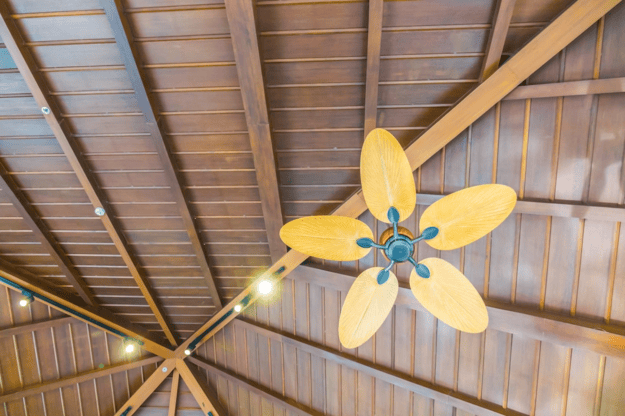Energy-saving fans, also called energy-efficient fans, are a smart choice for any home. They help keep your space cool, save money on your electric bills, and are good for the environment. In this article, we will explore the many advantages of using energy-saving fans in your home.
We will also answer some common questions and finish with a simple conclusion. Energy-efficient fans offer many benefits, whether you are looking to lower your energy costs or reduce your carbon footprint.
What Are Energy-Saving Fans?
Energy-saving fans use less power than regular fans. They are designed with special motors and blades that are made to move air more efficiently. Because they use less electricity, they are also called energy-efficient fans. These fans are available in many styles, from small desk fans to large ceiling fans. They are used in many homes to keep rooms cool in the summer and to improve air circulation all year round.
The design of energy-efficient fans is simple yet smart. They have motors that are built to last longer and use less energy. Their blades are designed to move air well, which means they can cool your room quickly without wasting power.
Benefits of Energy-Efficient Fans

1. Lower Energy Bills
One of the biggest benefits of using energy-saving fans is that they help lower your energy bills. Since they use less electricity, you pay less money for power. Over time, the savings can add up. This means that you can have a comfortable home without spending too much money each month.
2. Environmentally Friendly
Using energy-efficient fans is good for the environment. When you use less energy, you also reduce the amount of pollution that comes from power plants. This helps lower the overall electricity demand. By choosing energy-saving fans, you are making a choice that benefits the planet.
3. Long Life Span
Energy-efficient fans are built to last. They are made with high-quality materials and advanced technology. This means that they often last longer than older, less efficient fans. A fan that lasts longer means you do not need to replace it as often, which saves you money and reduces waste.
4. Improved Air Quality
These fans are designed to move air around your home efficiently. Better air circulation means that your rooms stay cooler and more comfortable. Good air circulation can also help reduce the buildup of dust and allergens, which is good for your health. In addition, using a fan to circulate air can help your air conditioner work more effectively, leading to a more pleasant home environment.
5. Quiet Operation
Energy-saving fans are known for running quietly. Many people prefer a quiet home where they can study, work, or sleep without loud noises. These fans use modern motors that reduce noise levels, so you can enjoy cool air without any distractions.
6. Versatile and Stylish
Today’s energy-efficient fans come in many designs and styles. You can find them as ceiling fans, wall fans, portable fans, or even table fans. This means that you can choose a fan that fits well with your home décor. Whether your style is modern, traditional, or something in between, you can find an energy-saving fan that looks great and works well.
7. Reduced Heat Build-Up
By using an energy-saving fan, you help reduce heat build-up in your home. Fans work by moving air, which makes the room feel cooler even if the temperature does not drop significantly. This can be very helpful in hot weather, making your home more comfortable during the summer.
8. Cost-Effective Cooling Option
Compared to other cooling options like air conditioners, energy-efficient fans are much cheaper to run. Air conditioners use a lot of energy, and they can make your bills skyrocket during hot months. In contrast, fans use a small fraction of that energy while still providing comfort. They are a cost-effective way to keep your home cool without the high costs.
9. Easy to Install and Use
Energy-saving fans are usually very easy to install and use. Many models come with simple instructions that anyone can follow. They do not require a lot of technical know-how, which makes them a perfect choice for many families. Once installed, you can control the speed and direction of the fan with a simple switch or remote control.
10. Health Benefits
Good air circulation can have positive effects on your health. By reducing the amount of stagnant air in your home, energy-efficient fans help to lower the chances of mold and mildew growth. This can lead to better respiratory health, especially for those who suffer from allergies or asthma. A well-ventilated room is important for overall well-being.
How Energy-Saving Fans Work
Energy-saving fans use modern motors and advanced designs to move air efficiently. Here is a simple explanation of how they work:
- Efficient Motors:
Energy-efficient fans have motors that are designed to use less power. They convert electricity into movement more effectively than older models. This means you get the same cooling effect with less energy. - Specially Designed Blades:
The blades of an energy-saving fan are shaped to push air smoothly and effectively. They are usually wider or curved in a special way to move more air with each turn. This design helps the fan cool your room faster. - Variable Speeds:
Many energy-efficient fans come with adjustable speeds. You can change the speed of the fan depending on how much air you want to move. This helps save energy because you can use a lower speed when you do not need a lot of air movement. - Smart Controls:
Some energy-saving fans come with smart features, such as timers or remote controls. You can set them to turn off automatically after a certain period, which helps prevent unnecessary energy use. These controls make it easy to use the fan only when needed. - Better Air Circulation:
By moving air around your home, energy-saving fans help to even out the temperature in your room. This means that the cool air from your air conditioner can spread more evenly, making the room feel cooler without using extra energy.
Comparing Energy-Saving Fans with Regular Fans
Energy Use
Regular fans often use more electricity because their motors are not as efficient. They might work fine, but they do not save as much energy as modern, energy-efficient fans. This means that over time, using a regular fan could cost you more money on your electric bill.
Lifespan
Energy-saving fans are built with better materials and are designed to last longer. Regular fans might need to be replaced sooner, which means you have to spend more money on repairs or new fans. In the long run, energy-saving fans are a better investment.
Noise Levels
Many older fans can be noisy because of the older motor designs and worn-out parts. Energy-efficient fans use newer technology that makes them run much more quietly. This is important in a home where you want peace to study, work, or sleep.
Environmental Impact
Using less electricity means that energy-saving fans help reduce the overall power demand. This can lead to less pollution and a smaller carbon footprint. Regular fans that use more power contribute more to energy waste and environmental problems.
How to Choose Energy-Saving Fans for Your Home

When you decide to buy energy-efficient fans, there are a few things you should consider:
1. Check the Energy Rating
Look for fans that have a high energy rating. This rating tells you how much power the fan uses compared to others. Fans with a better energy rating will use less electricity and save you more money.
2. Read Reviews
Before buying, read what other customers say about the fan. Reviews can tell you if the fan is quiet, efficient, and long-lasting. This information can help you make a good choice.
3. Consider the Size of the Room
Different rooms need different sizes of fans. A small desk fan might work well in a bedroom, while a larger ceiling fan might be needed for a living room. Make sure to choose a fan that is the right size for your space.
4. Look for Adjustable Features
Fans that allow you to adjust the speed and direction of the blades are very useful. These features let you control how much air is moving and can help save energy by using lower speeds when possible.
5. Think About Installation
Some fans are easier to install than others. If you are not very handy, look for fans that come with clear instructions or even professional installation services. This will help you avoid problems later on.
6. Compare Prices
Finally, . While it might be tempting to choose the cheapest option, remember that a higher-quality fan may save you more money in the long run by lasting longer and using less energy.
Tips for Using Energy-Saving Fans Effectively
Once you have your energy-efficient fan, there are several ways to use it to get the most benefit:
1. Use the Right Speed
Adjust the fan speed to suit your needs. If you only need a little air movement, use a lower speed. This will save energy and still keep your room comfortable.
2. Place Fans in the Right Spots
For the best air circulation, place fans where they can move air throughout the room. For example, a ceiling fan should be in the center of the room. Portable fans work best when placed near windows or open areas.
3. Combine with Other Cooling Methods
Using a fan together with an air conditioner can help cool your room faster. The fan spreads the cool air around, so you may not have to set the air conditioner as low. This helps reduce energy use even more.
4. Clean Your Fans Regularly
Keep your fan blades and motor clean. Dust and dirt can make the fan work harder and use more energy. Regular cleaning ensures that your fan stays efficient and lasts longer.
5. Use Timers and Smart Controls
If your fan comes with a timer or remote control, use these features to turn the fan off when you do not need it. This helps save energy by preventing the fan from running all day long.
6. Monitor Your Energy Use
Sometimes, checking how much energy your fan is using is a good idea. Many modern fans come with energy monitors or a simple plug-in meter. This way, you can see the benefits of using an energy-saving fan in real numbers.
Environmental Impact of Energy-Efficient Fans

Using energy-saving fans has a positive impact on the environment. Here are some simple points to remember:
- Less Electricity Use:
When you use less electricity, fewer power plants are needed to supply your home. This means less pollution is created from burning fuel. - Lower Carbon Footprint:
Every device that uses energy leaves a mark on the environment. By choosing energy-efficient fans, you reduce your overall carbon footprint. This helps fight climate change and protects our planet. - Reduction of Waste:
Energy-saving fans often last longer than regular fans. When you do not have to replace them as often, there is less waste. This is good for the environment and helps keep landfills smaller. - Support for Green Technology:
Buying energy-efficient products sends a message to companies that you care about the planet. This encourages more businesses to develop green technology and products that are better for the environment.
FAQs
1. What Are Energy-Efficient Fans?
Energy-efficient fans, also known as energy-saving fans, are fans that use less electricity than regular fans. They are designed with modern motors and special blades to move air effectively while using less power.
2. How Do Energy-Saving Fans Save Energy?
These fans save energy by using advanced technology that makes the motor work better and the blades move more air with less effort. This means you get the same cooling effect without using as much electricity.
3. Are Energy-Efficient Fans Expensive to Buy?
Energy-efficient fans may cost a little more initially compared to older models, but they save you money in the long run. Lower energy bills and longer life spans make them a good investment.
4. How Often Should I Clean My Energy-Efficient Fan?
It is a good idea to clean your fan every few months. Dust can accumulate on the blades and motor, causing the fan to work harder. Regular cleaning keeps your fan efficient and extends its life.
5. Can I Use an Energy-Efficient Fan with My Air Conditioner?
Yes, using a fan with your air conditioner can help cool your room faster. The fan helps spread the cool air throughout the space, which can reduce the need for a lower air conditioner setting.
6. What Size Fan Do I Need for My Room?
The size of the fan depends on the size of your room. A small room might only need a desk or wall fan, while a larger room could benefit from a ceiling fan. Look for a fan that fits the space well for the best results.
7. What Should I Look for When Buying an Energy-Efficient Fan?
When shopping for a fan, check its energy rating, read reviews, and compare features. Look for adjustable speeds, quiet operation, and a design that fits your room. Choosing the right fan will help you get the most benefits.
8. Are Energy-Efficient Fans Better for the Environment?
Yes, they are. Because energy-efficient fans use less electricity, they help reduce the amount of pollution created by power plants. They also have a lower carbon footprint and last longer, which means less waste over time.
9. How Can I Tell if My Fan Is Truly Energy-Efficient?
Look for certifications or energy ratings on the product. Many fans will have labels that show they meet energy-saving standards. Reading customer reviews and professional ratings can also help you decide.
10. Can Energy-Efficient Fans Make a Difference in My Electric Bill?
Yes, they can. Since these fans use less energy, they can help lower your electric bill over time. While the savings might seem small at first, they add up over months and years.
Conclusion
Using energy-saving fans in your home brings many advantages. They help lower your electric bill, reduce your impact on the environment, and keep your home more comfortable. Energy-efficient fans are designed to use less power and last longer, which means you save money and help protect our planet.
